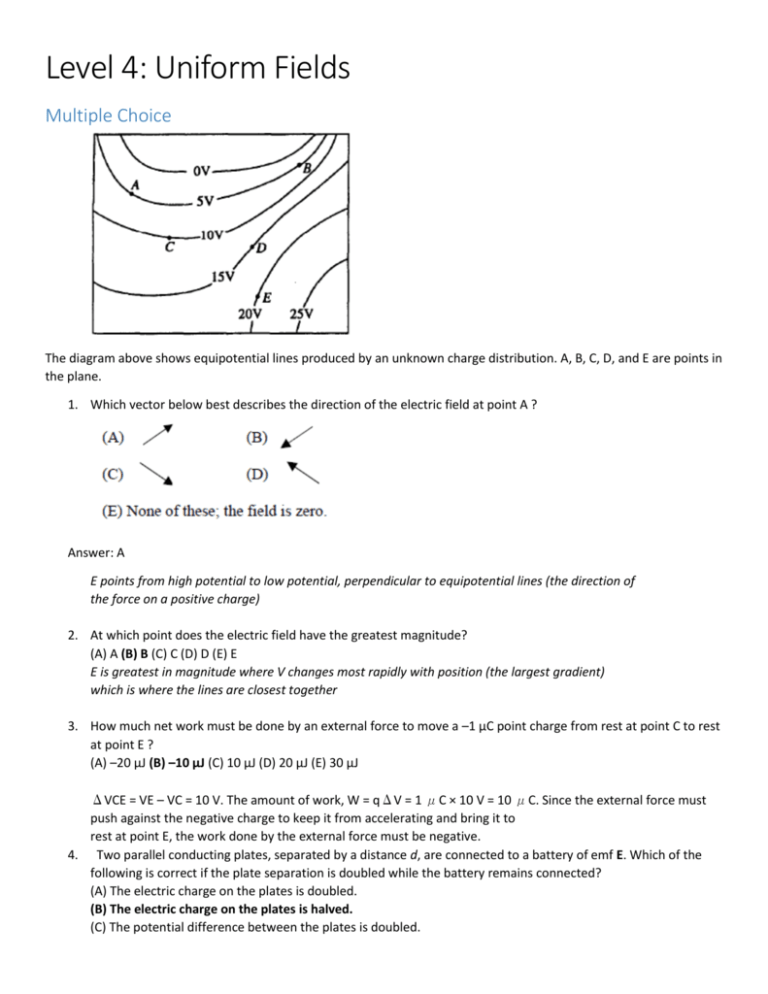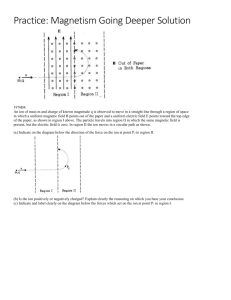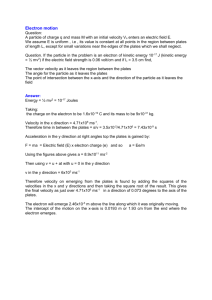The diagram above shows equipotential lines produced by an
advertisement

Level 4: Uniform Fields Multiple Choice The diagram above shows equipotential lines produced by an unknown charge distribution. A, B, C, D, and E are points in the plane. 1. Which vector below best describes the direction of the electric field at point A ? Answer: A E points from high potential to low potential, perpendicular to equipotential lines (the direction of the force on a positive charge) 2. At which point does the electric field have the greatest magnitude? (A) A (B) B (C) C (D) D (E) E E is greatest in magnitude where V changes most rapidly with position (the largest gradient) which is where the lines are closest together 3. How much net work must be done by an external force to move a –1 μC point charge from rest at point C to rest at point E ? (A) –20 μJ (B) –10 μJ (C) 10 μJ (D) 20 μJ (E) 30 μJ ΔVCE = VE – VC = 10 V. The amount of work, W = qΔV = 1 μC × 10 V = 10 μC. Since the external force must push against the negative charge to keep it from accelerating and bring it to rest at point E, the work done by the external force must be negative. 4. Two parallel conducting plates, separated by a distance d, are connected to a battery of emf E. Which of the following is correct if the plate separation is doubled while the battery remains connected? (A) The electric charge on the plates is doubled. (B) The electric charge on the plates is halved. (C) The potential difference between the plates is doubled. (D) The potential difference between the plates is halved (E) The capacitance is unchanged. If the battery remains connected, the potential remains constant. C decreases as the separation increases soothe charge Q = CV will also decrease 5. Two large oppositely charged insulated plates have a uniform electric field between them. The distance between the plates is increased. Which of the following statements is true? I. The field strength decreases. II. The field strength increases. III. The potential difference between the plates increases. (A) I only (B) II only (C) III only (D) I and III only (E) II and III only Since the plates are insulated, the charge remains constant. If the distance is increased, the capacitance will decrease (C ∝ A/d) and since Q = CV, the potential difference must increase by the same factor that the distance increases. This means E = V/d remains the same 6. If the separation between the plates of an isolated charged parallel-plate capacitor is increased slightly, which of the following also increases? (A) The capacitance (B) The stored electrostatic energy (C) The force of attraction between the plates (D) The magnitude of the charge on each plate (E) The magnitude of the electric field in the region between the plates Since the plates are insulated, the charge remains constant. If the distance is increased, the capacitance will decrease (C ∝ A/d) and since Q = CV, the potential difference must increase by the same factor that the distance increases. UC== ½ QV Free Response 2003Bb4. An electric field E exists in the region between the two electrically charged parallel plates shown above. A beam of electrons of mass m, charge q, and velocity v enters the region through a small hole at position A. The electrons exit the region between the plates through a small hole at position B. Express your answers to the following questions in terms of the quantities m, q, E, θ, and v. Ignore the effects of gravity. a. i. On the diagram of the parallel plates above, draw and label a vector to show the direction of the electric field E between the plates. ii. On the following diagram, show the direction of the force(s) acting on an electron after it enters the region between the plates. iii. On the diagram of the parallel plates above, show the trajectory of an electron that will exit through the small hole at position B. b. Determine the magnitude of the acceleration of an electron after it has entered the region between the parallel plates. c. Determine the total time that it takes the electrons to go from position A to position B. d. Determine the distance d between positions A and B. e. Now assume that the effects of gravity cannot be ignored in this problem. How would the distance where the electron exits the region between the plates change for an electron entering the region at A? Explain your reasoning. More Free Response *1986E1. Three point charges produce the electric equipotential lines shown on the diagram above. a. Draw arrows at points L, N. and U on the diagram to indicate the direction of the electric field at these points. Solution







